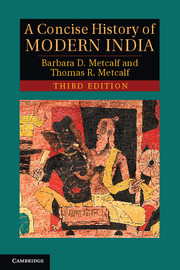Book contents
- Frontmatter
- Contents
- Illustrations
- Preface to the third edition
- Preface to the first edition
- Glossary
- Chronology
- 1 Sultans, Mughals, and Pre-Colonial Indian Society
- 2 Mughal Twilight: The Emergence of Regional States and the East India Company
- 3 The East India Company Raj, 1772–1850
- 4 Revolt, the Modern State, and Colonized Subjects, 1848–1885
- 5 Civil Society, Colonial Constraints, 1885–1919
- 6 The Crisis of the Colonial Order, 1919–1939
- 7 The 1940s: Triumph and Tragedy
- 8 Congress Raj: Democracy and Development, 1950–1989
- 9 Democratic India at the Turn of the Millennium: Prosperity, Poverty, Power
- Biographical notes
- Bibliographic essay
- Index
7 - The 1940s: Triumph and Tragedy
Published online by Cambridge University Press: 05 November 2012
- Frontmatter
- Contents
- Illustrations
- Preface to the third edition
- Preface to the first edition
- Glossary
- Chronology
- 1 Sultans, Mughals, and Pre-Colonial Indian Society
- 2 Mughal Twilight: The Emergence of Regional States and the East India Company
- 3 The East India Company Raj, 1772–1850
- 4 Revolt, the Modern State, and Colonized Subjects, 1848–1885
- 5 Civil Society, Colonial Constraints, 1885–1919
- 6 The Crisis of the Colonial Order, 1919–1939
- 7 The 1940s: Triumph and Tragedy
- 8 Congress Raj: Democracy and Development, 1950–1989
- 9 Democratic India at the Turn of the Millennium: Prosperity, Poverty, Power
- Biographical notes
- Bibliographic essay
- Index
Summary
On 3 September 1939, on the outbreak of the Second World War, the viceroy Lord Linlithgow declared India, alongside Britain itself, at war with Hitler's Germany. Two months later, in protest against this unilateral act, which appeared to Indians as a reassertion of high-handed British imperialism, the Congress ministries in the provinces resigned. In March of 1940, taking advantage of what they saw as a fortuitous ‘deliverance’ from Congress rule, the Muslim League, at its annual meeting in Lahore, enacted the Pakistan Resolution, with its ill-defined demand for independent Muslim states. The stage was set for the crises that were to dominate the decade of the 1940s – the war, the Congress's final movement of non-cooperation, the rise of Muslim nationalism, and then, finally, in 1947 independence, with the devastating partition of the subcontinent into two states.
The unilateral declaration of war, a provocative act of the sort that had so often characterized British policy in India, was a tactical blunder. So too, arguably, was the resignation of the Congress ministries, which set in motion a protracted series of negotiations and acts of civil disobedience that were to culminate in the climactic August ‘rising’ of 1942. During the later 1930s Britain and India had been drifting slowly towards an amicable parting of the ways. Britain's stake in India had been declining as economic nationalism took hold around the world, while on the political front, after 1937, Congress politicians had demonstrated an ability to govern that augured well for an independent India. The coming of the war, with the resignation of the Congress ministries, changed everything. Now, suddenly, with its back to the wall, fighting first Hitler, and then from December 1941 the Japanese as well, the British were desperate to retain access to the resources, in men and matériel, as well as the secure bases that India supplied. The Indian Army was increased in size tenfold to fight in the Middle East and South-East Asia, as well as to protect the homeland as the Japanese in 1942 advanced on Assam. As the British endeavoured to feed, clothe, and arm this immense force, they consumed their investments in India; by the end of the war, no longer Britain's debtor, India had piled up sterling balances in London of over 1,000 million pounds.
- Type
- Chapter
- Information
- A Concise History of Modern India , pp. 203 - 230Publisher: Cambridge University PressPrint publication year: 2012



